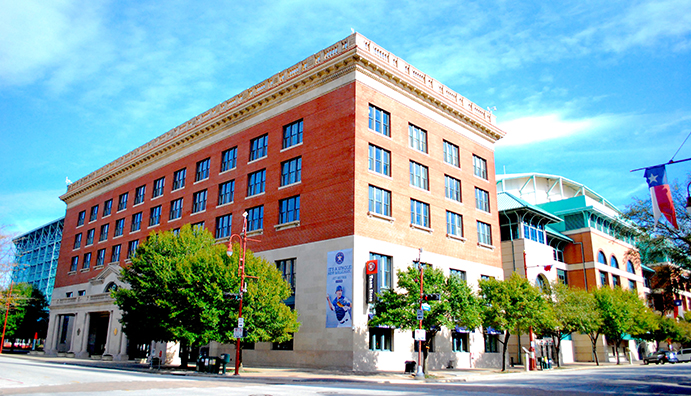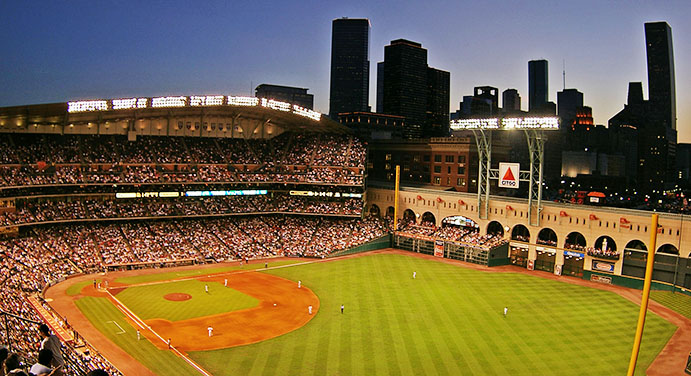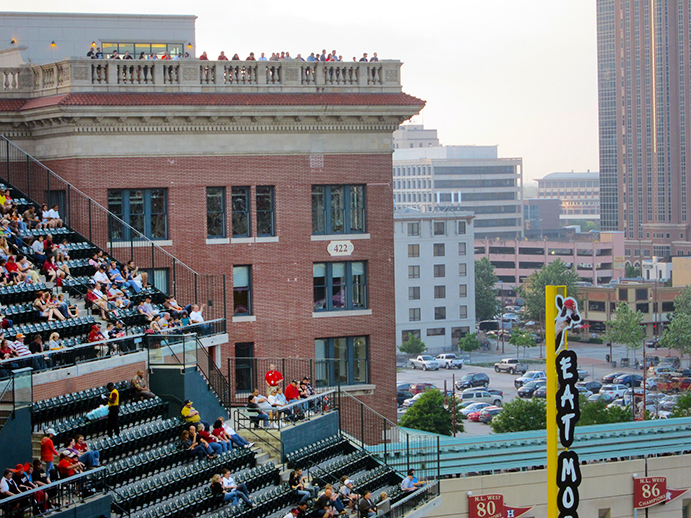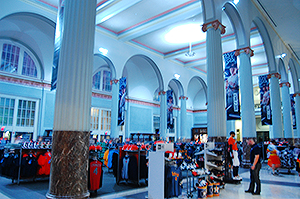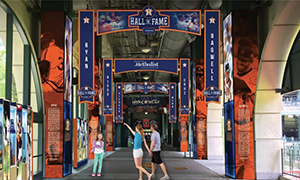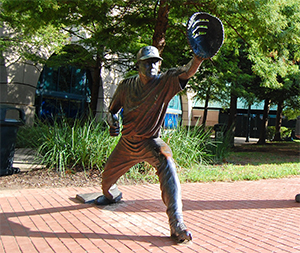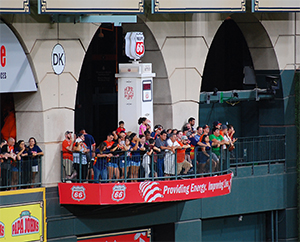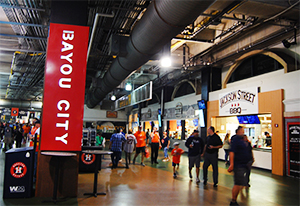THE BALLPARKS
Minute Maid Park
Houston, Texas
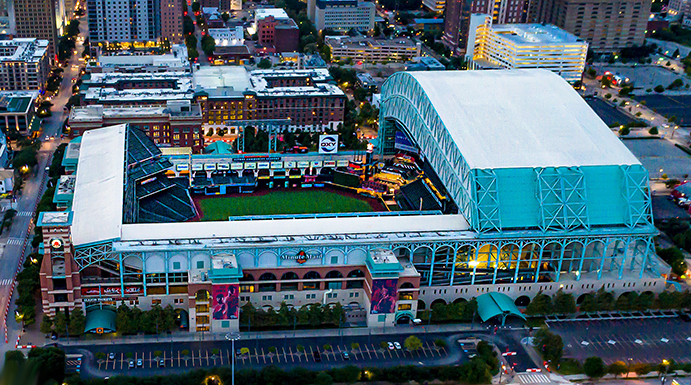
(iStock)
Some people thought the Houston Astros were taking a chance moving back to the outdoors. They remember the mosquitoes—big, nasty, hungry critters—that preyed on spectators when the franchise first began business 40 years earlier. In lieu of the world’s largest patio netting, the Astros have chosen instead to construct a retractable roof at Minute Maid Park to keep the bugs—to say nothing of the sweltering summer heat—outside.
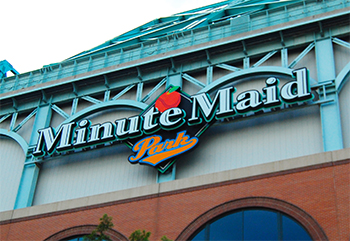 “Take it outside.” That’s what Mom always says when she fears that her kids’ rambunctious behavior will turn the family room into a disaster zone. For those kids in Houston, their response to Mom’s edict is to carefully choose between better indoor behavior in air-conditioned comfort, or letting it loose outside on a hot summer day where sweat, mosquitoes and a rapidly swelling urge to suck down lemonade rule.
“Take it outside.” That’s what Mom always says when she fears that her kids’ rambunctious behavior will turn the family room into a disaster zone. For those kids in Houston, their response to Mom’s edict is to carefully choose between better indoor behavior in air-conditioned comfort, or letting it loose outside on a hot summer day where sweat, mosquitoes and a rapidly swelling urge to suck down lemonade rule.
The Houston Astros were confronted with such a choice. After 30 years in the Astrodome, they yearned to take it outside. But in reality, they wanted to have it both ways—with the ability to play ball under blue Texan skies, or inside if things outside got uncomfortably muggy or buggy.
The Astros’ answer would be Minute Maid Park, a sprightly playhouse located in the backyard of downtown Houston. Outdoor baseball, once upon a time considered a tortuous exercise for Houston baseball players and fans, could resume under the right conditions—but if the elements became too much, as it often does during Houston’s summer months, the Astros wouldn’t go indoors; the indoors would come to them. At the push of a button, three massive overhead panels would do their thing, enclose the ballpark and provide much-needed shade for those sweltered below.
Minute Maid Park is as aesthetically removed from downtown as it is physically, set apart on the district’s eastern edge. Bathed in a palette of turquoise, vanilla, tan and brick red with a curved roof that arcs and slopes as if a first take by a designer breaking out a pencil and French curve, the ballpark stands in high contrast to the angular, sleek yet achromatic slices of looming skyscrapers nearby.
While Minute Maid Park inside is, from pole to pole, highly satisfying yet ordinary, it’s the bleachers and beyond that steal the show—providing the ballpark with essentially all of its energetic character.
In the left-field corner, there’s the centenarian Union Station, the former rail depot that serves as the ballpark’s architectural inspiration. Sticking out into left field are the Crawford Boxes, a source of irritation for pitchers who despise the section’s close proximity to the infield. Behind in the elevated concourse, with arched openings to expose the action on the field, fans can stroll through the Astros’ Hall of Fame and absorb Houston’s rich baseball history. Above, Minute Maid Park’s bells and whistles literally become just that, with an 800-foot railroad track featuring a bigger-than-life locomotive that steams into action whenever the Astros belt a home run or make the victorious final out. Towering high behind the train is a wall of hurricane-proof glass that forms one side of the retractable roof, allowing the setting sun to peak through and give the ballpark a sense of external atmosphere even when the roof is closed. Finally, behind center field and points right, there stands a virtual vertical food court with enough signage and vibrancy to leave even those sitting in the pricey Diamond Club seats back behind home plate wondering if they’re missing out on something.
Minute Maid Park has proved to be the savior for Houston baseball and been the setting for numerous chapters of Astros history, whether good, bad or scandalous. It indeed has allowed the Astros to take it outside whenever they want.
Built in 1911, Union Station was all but abandoned when the Astros decided to revive it as an annex to Minute Maid Park, mimicking its exterior design. (Wikimedia—Brian Reading)
Down on the Dome.
It would have been hard to fathom back in 1965 that the newly opened, avant-garde Astrodome would, three decades later, become an air-conditioned bore. The Eighth Wonder of the World had long lost its Mojo, with all the fancy touches applied by Astrodome mastermind Roy Hofheinz tarnished or forgotten. As with many of the other multi-purposed stadia of the era, the Astrodome had undergone upgrades that seemed to better benefit the venue’s pro football tenant, the Oilers—with newly installed seats knocking out the massive and original outfield scoreboard display. By the mid-1980s, the disgruntled Astros were rumored to be headed eastward, with Washington or Jacksonville getting the most attention.
Such fears were momentarily allayed in 1992 when Drayton McLane, owner of a trucking distribution company and, more importantly, WalMart’s second largest shareholder, bought the Astros and the Astrodome for $115 million. But reality set in quickly for the new Lord; losing $20 million a year on your baseball team will tend to do that. McLane complained that the high school football team back in his upstate hometown of Temple drew more on a Saturday night than the Astros. A USA Today article gave McLane fuel for his fussing when it revealed that the Astros ranked dead last among all major league teams in ballpark revenue.
By the end of 1995, his third year running the Astros, McLane publicly announced that the status quo would no longer be accepted. He first asked that $60 million in public dollars be scurried up to make Astrodome improvements. When that fell on deaf ears, he made another announcement that surely would not—publicly announcing negotiations with a potential buyer intent on moving the franchise to Northern Virginia. Panic set in among the local community, and for good reason. Houston, after all, had faced that bluff before—except it wasn’t one; the Oilers wanted a better place to play, didn’t get it, and made good on a threat to relocate to Tennessee.
“Uncle!” shouted Harris County. The public overseers of all Houston sports facilities said it would pay heed to McLane’s plea for a new ballpark. But it wasn’t going to be decided in a boardroom; Judge Robert Eckels, Harris County’s top dog, told McLane that if he was going to stake his reputation on an expensive new building for a private entity, the voters would need to have a say.
Goin’ Downtown.
Midway through 1996, Eckels announced a referendum, Proposition 1, in which $250 million would be spent on a new ballpark; the Astros would agree to contribute a quarter, or $62.5 million, of the funds. Interestingly, the venue’s location had yet to be decided—and the dueling thus began between two camps: One which wanted a downtown ballpark, the other seeking to build next to the Astrodome within its voluminous parking lot. For much of that summer, the Astrodome faction looked to be the odds-on favorite; private boosters lobbied that a new ballyard could be tied to an expansive, intertwining development that included an Astrodome remodeled for football, a new aquarium, a rejuvenated Sea World across the street and a monorail to connect it all.
But downtown backers had the bigger carrot stick. A collective of top local business leaders led by rising corporate superstar Ken Lay, CEO of the ambitious energy services supplier Enron, pledged $35 million toward a downtown venue—nearly half of it for ballpark land and the rest loaned to the Astros at zero interest. McLane, an early proponent of the Astrodome site, was seduced by the financial gift from Lay’s group and decided to go all in on downtown. Judge Eckels followed suit and announced the proposed site as official just seven weeks before Election Day. Ironically, Eckels and McLane made the announcement at the Astrodome amid the smell of smoke from a small fire that had earlier broken out inside the stadium.
On those few nights when the roof is open, fans sitting high up along the right-field line get a nice view of downtown Houston. (Wikimedia—Adam Baker)
Pre-election polls were all over the place, with results careening from sure victory to shattering defeat. The pro-ballpark campaign took an inculpable hit just two weeks before the vote when Harris County commissioners hiked property taxes by 4%—planting conspiratorial seeds in the heads of many voters who sensed that county officials okayed the increase to help cover the public cost of any new ballpark.
Proposition 1 looked to be in early trouble as absentee ballots strongly ran against the measure. But real-time voters saved the day; the measure passed by a slim 51-49% margin, as no-votes cast in the outlying suburbs weren’t enough to offset the approval of those deep within Loop 610—especially those of color, bolstered over the Astros’ pledge to give minority firms at least 30% of ballpark construction contracts. (Had they known that such firms would ultimately end up getting less than 10% of the work, they might had voted differently.)
The measure may have passed, but the Astros were not yet in the clear. The proposition didn’t specify how the public funds for the ballpark would be raised, so it was up to the Texas State Legislature to make that determination as part of a larger state-wide discussion on the use of taxes for such facilities. What was expected to be a formality nearly turned into the Astros’ worst nightmare. Disparate interests descended upon Austin to initiate a tug-of-war; representatives for cities, rural towns, the hospitality and car rental industries and many others duked it out, trying to avoid financial pain at the expense of someone else’s gain. The legislature believed it had gotten everyone on board and put the round peg in the polygon-shaped hole—stating that publicly-built sports facilities could be realized only with city/county funds, not those of the state.
But the Astros and Harris County were horrified to learn that because Proposition 1 didn’t explicitly detail its funding sources, it would have to spell those out—and another referendum would be needed. Austin said, “Relax, we got this,” finagled the edict and grandfathered in the results of Proposition 1 because officials were pressed for time to get a ballpark built by 2000. But that still didn’t satisfy ballpark opponents who saw the political circus as momentum to attempt one last stab at overturning the vote. The 11th-hour agitators failed in their quest, but they riled Drayton McLane to the point that he publicly threatened to reopen relocation talks with the folks in Northern Virginia.
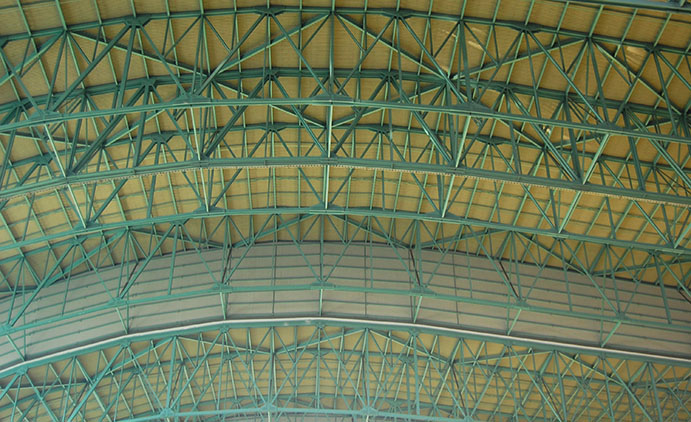
Close-up of Minute Maid Park’s retractable roof ceiling. The complex steelwork is said to be influenced from railroad yards of the past.
Put a Lid on It.
Among Minute Maid Park’s many pre-design debates was whether the ballpark should include a fixed roof or be exposed to the outdoors. McLane at first was cool to the latter idea—evoking the memory of Colt Stadium, the mosquito-infested natural oven that served as the Astros’ first home during the early 1960s. Others echoed his sentiments, such as the Houston Chronicle’s Dale Robertson who wrote, “Air-conditioning made Houston possible. We don’t want to sweat again.”
There was the third option of a retractable roof, a perfect-world but fiscally dubious thought given the ballpark’s tight $250 million budget. While Houstonians didn’t want to melt in the summer heat, they also didn’t want to be inside a building watching baseball when they could be afforded a view of downtown. The new wave of ballparks interacting with their surrounding urban environments only made the Astros and their fans more willing to embrace the ideal compromise.
HOK Sport, the Kansas City-based architectural firm commissioned by the Astros to design the ballpark, found inspiration from nearby NASA to meet the retractable roof challenge. Working with engineers, it was decided to model the track apparatus after those used to slowly and carefully move space vehicles into place at Cape Canaveral, Florida. The roof would consist of three panels, the top two of which would quietly cascade outward from behind right field and seal the ballpark in roughly 13 minutes. The shape of the 9,000-ton roof was curious in that it gently sloped up from above home plate toward left field, like a rolling hillside, then quickly dipped back down; this was designed as such to shadow a high fly ball with a minimum of interference, which a ceiling apex of 210 feet—or just two feet higher than the Astrodome’s highest point.
With a lifespan of 730 miles—or roughly 50 years—Minute Maid Park’s roof is one of the venue’s great triumphs. It was completed and installed on budget and on schedule with virtually no snags for $65 million—in sharp contrast to three other lid-covered ballparks built at roughly the same time (Seattle, Phoenix and Milwaukee) plagued by major cost overruns, scheduling delays or, tragically in the case of Milwaukee’s Miller Park, a partial structural collapse caused by a failed crane that killed three construction workers. (Interestingly, Minute Maid Park was the only of the four designed by HOK Sport.)
The Union Station Forever.
Below the roof, HOK Sport took a cue from its highly lauded work on Baltimore’s Oriole Park at Camden Yards and derived Minute Maid Park’s architectural look from an all-but-condemned railroad building. Union Station, designed by the same architects who drew up New York’s iconic Grand Central Station, was built in 1911 as a three-story passenger center for Houston, which had grown from virtually nothing thanks to the railroad industry. Within a few short years, Union Station expanded to five stories with up to 10 tracks accommodated by covered depot walkways emanating from underneath, stretching outward for passengers. It remained popular through the 1940s, but eventually the Interstate and airports won the day—and by 1974, Union Station ran its last passenger train and assumed a shuttered presence that only the folks from Ghost Adventures could love.
There was already movement afoot to resuscitate Union Station before Minute Maid Park became a thing, as the City of Houston budgeted $2 million to make it operational again for local service. But the ballpark’s approval changed things; momentum shifted toward Union Station becoming more of a symbolic beacon for arriving fans than a functioning train station. When plans for a Houston-to-Galveston line fell through because of low interest, the Astros were all too happy to take Union Station over—even happier to get rid of the tracks, allowing the ballpark bowl more space while having the building provide shade for first basemen and the fans seated behind them from the setting sun.
In restoring Union Station’s majesty, the Astros removed a faux ceiling that hid the upper half of a grand, three-story central lobby, revealing soaring arches and columns with marble bases. Since the ballpark’s opening, it’s been used for formal functions and, on game days, as a team souvenir store. The bulk of the building serves as the Astros’ headquarters; on the top floor at the northeast end, facing the ballpark, sits the owner’s office with a 422-foot marker sign attached on the outside. Drayton McLane hoped that someone would crash a home run through his window, insisting that the glass not be break-proof because anyone who reached it, he said, should deserve to shatter it. As of yet, no one has.
Further above, on Union Station’s rooftop, the Astros sensed a revenue opportunity. A party deck allows up to 100 spectators to wine, dine and enjoy the game from a unique vantage point. If the glass wall behind left field provides too much obstruction when the roof is closed, rooftop guests can turn around and enjoy a magnificent view of downtown Houston.
Architectural critics were disappointed that Minute Maid Park looked backward instead of forward, assailing the retro bandwagon the Astros jumped upon over something more modern and futuristic as the Astrodome had done. But the Astros’ choice to absorb Union Station’s aesthetic personality into the ballpark sealed the deal for the embracement of yesteryear. Minute Maid Park mimics Union Station with its red brick exterior and arched windows, broken up by horizontal streaks of limestone; the Astros even erected the clock tower Union Station never had, standing tall over the ballpark’s southeast (home plate) entrance.
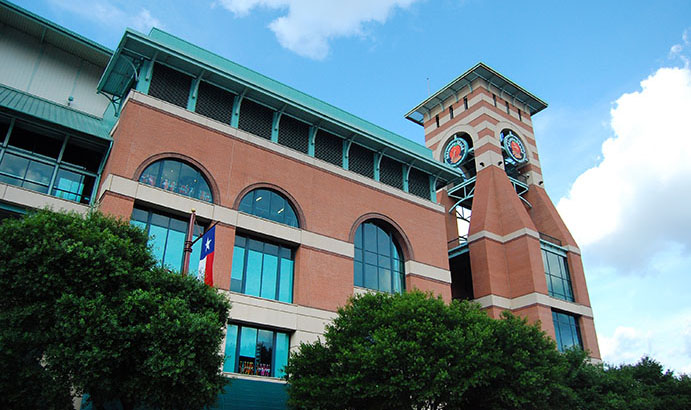
Minute Maid Park’s southeast corner features a clock tower that Union Station never had. All of the ballpark’s primary architectural ingredients are on display: Red brick, horizontal streaks of limestone, arched windows and turquoise awnings.
Disneyfication.
If you’re gonna have a railroad station, shouldn’t there be a train somewhere? Though it wasn’t part of the original plans, the Astros and HOK decided it would be fun to include an actual operating locomotive on the premises. For a remarkably trim $1.5 million, a railroad track stretching 800 feet on a straight line behind left field, high above the playing field and Crawford Boxes, was built into Minute Maid Park with an 1860-replica locomotive. Built and transported from Porter, Minnesota, the 30-ton locomotive is actually 25% larger than its ancestors; the Astros wanted to make it big enough for everyone in the ballpark to see. It runs a slow 2.5 MPH but can speed up to 10, with manual brakes; that puts all the onus on driver Bobby “Dynamite” Vasquez from fainting and crashing the train into Union Station. And why would Vasquez, who’s piloted the train since 2001, be fainting in the first place? He admits to a touch of vertigo, operating on a track that has no railing and a straight 70-foot drop to the playing field below.
The locomotive is just part of the eye candy that all but overwhelms Minute Maid Park from the left-field foul pole to just right of center. The concourse below the train track features several historical kiosks that was transcended in 2019 into the Astros’ Hall of Fame, complete with stylish graphics, plaques and memorabilia displays. It’s also a popular place for fans to stop and admire the action, particularly in a semi-circular overhang above left-center field that includes a 12-foot-tall gas pump with a digital counter displaying the number of home runs hit by the Astros since the ballpark’s opening.
Then there’s the Crawford Boxes. Starting from the left-field foul pole and running 128 feet toward left-center, the lone but attentive bleacher section is 10 rows deep, seats 800 fans, and plays with the head of every pitcher who’s taken the mound at Minute Maid Park. The Astros strained for bleachers on the left side but were restricted by space thanks to Union Station; thus the Crawford Boxes sit in close proximity to the infield, a mere 315 feet down the line from home plate, and only 335 on the other end before sharply receding back to more normal dimensions in left-center.
The Crawford Boxes are fronted by a 21-foot wall dominated by a manual out-of-town scoreboard, all to evoke the Green Monster at Boston’s Fenway Park—just one of several homages to classic ballparks of yore the Astros thought of at Minute Maid Park. When the ballpark opened, there was also Tal’s Hill—a deep feature in straight-away center that included a six-foot grassy incline fashioned after Cincinnati’s Crosley Field, and a flag pole in play that channeled Detroit’s Tiger Stadium—all leading to an outfield wall measuring 436 feet from home plate, at the time the majors’ deepest reach at any ballpark.
Tal’s Hill was the brainchild of longtime Astros executive Tal Smith, who had started his baseball career with the Reds during their Crosley days, and was instrumental in helping to visualize the Astrodome. Smith originally thought of the warning track incline in front of the Crawford Boxes, but he backed off the idea once he figured that the short distances and tall wall was hardship enough on left fielders. That left center fielders to curse Tal’s Hill; several star players did just that after tripping over themselves once they found themselves unexpectedly climbing the hill. In one game early in the ballpark’s inaugural year of 2000, Atlanta’s Gold Glove center fielder Andruw Jones had to run up the hill on consecutive pitches—dropping the ball the first time, hanging on with the second, and stumbling to the ground on both occasions. After the second sprint, time had to be called so Jones could collect his breath, to say nothing of his sea legs.
In 2016, Tal’s Hill was removed—reducing both triples and trips. In its place was a tall batter’s eye (out of play) with fake ivy and a darker green Astros insignia in the middle, reducing center field dimensions to 409 feet. At the same time, the Astros went about a makeover of the concessions area above and to the right of the eye, with several bars, private party areas, a taco joint, wing bar and shake stand all stacked up here, there and everywhere; there’s even a golf shop, dedicated to the PGA’s Houston Open—which happens to be promoted by Drayton McLane’s successor, Jim Crane. Throw in a menagerie of open staircases, a vertical digital board topped by a 3-D Astros logo, and advertisements large and small in every conceivable spot, and the entirety of Minute Maid Park’s expanse from left field to right-center comes across as another homage—this one to Times Square.
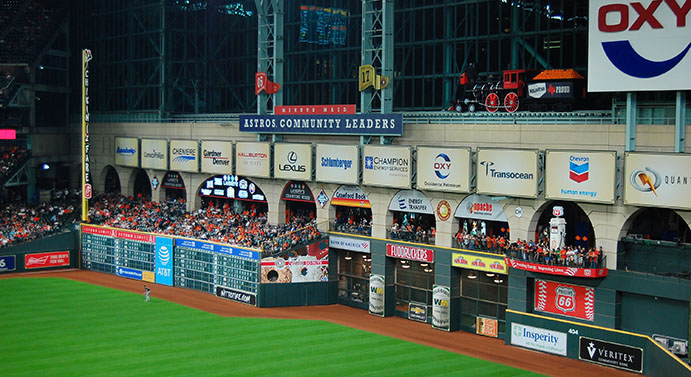
The area behind left field at Minute Maid Park resembles a virtual funhouse with the intimate Crawford Boxes bleacher section, the balcony overhang to its right, and an operational locomotive that moves across 800 feet of track when the Astros do something cool—like hit a home run or win.
We’re So Sorry, Jose Lima.
Originally titled the Ballpark at Union Station, Minute Maid Park opened in 2000 under a different name: Enron Field, after Ken Lay’s high-flying corporation paid $100 million over 30 years to place its name on the venue. Construction of the ballpark finished on time and on budget despite the flaring up of a few issues, such as delays created by Hurricane Frances late in 1998 and the ensuing fear of cost overruns as a result.
After a trial run exhibition against the New York Yankees, which is exactly how the Astrodome opened 35 years earlier, things got real—and real bad—for the Astros at their new home.
Arriving at Enron Field on the heels of three straight divisional titles, the Astros felt they could apply the same tactics that made them win at the Astrodome. But Enron Field was not the Astrodome; in fact, it wasn’t even close. Whereas the Astrodome’s cool, dead air conditions took the life out of fly balls, Enron Field seemed to turn every night into a Home Run Derby. In just the ballpark’s fourth-ever game, an 8-7 loss to the St. Louis Cardinals, both teams combined for eight home runs—two more than any ballgame ever played at the Astrodome. Houston pitchers kept challenging opposing hitters with fastballs down the middle, as they safely had at the Astrodome—but at Enron Field, the hitters happily met the dare and blasted away in much livelier air, amid smaller dimensions.
Nobody felt the sting of Enron Field’s bandbox needle more than Jose Lima. A year earlier, the right-hander was a 21-game winning All-Star with a stable 3.58 earned run average. In 2000, the new ballpark turned him into a clueless wreck. After winning his first start—on the road—Lima lost 13 straight and possessed a 7.52 ERA at the All-Star Break. Enron Field wigged Lima out to the point that he couldn’t retrieve his confidence on the road. By the end of the year, Lima finished 7-16 with a 6.65 ERA; his 48 home runs allowed (27 at Enron) set a National League record, while the 145 earned runs he surrendered were the most by a major league pitcher this side of Phil Niekro in 1977. Lima never recovered from the Enron experience; he bounced around six more years for five different teams, unable to overcome the shellshock of 2000. In 2010, at the age of 37, he suffered a fatal heart attack.
The Astros in general were a mess in Enron Field’s inaugural campaign. They were 32-62 at one point and held the majors’ worst record all the way through mid-August before rebounding late in the year to finish at 72-90. Houston’s 5.41 team ERA was the NL’s worst; only one Astro, late-season call-up Tony McKnight, was able to supply an individual sub-4.00 ERA. Injuries didn’t help, with extended injuries to closer Billy Wagner, slugger Ken Caminiti and All-Star second baseman Craig Biggio—who banged up his knee after colliding with outfielder Lance Berkman while chasing a wind-blown pop fly with the roof open.
Houston’s bats also benefitted from the new yard’s cozy confines, but not enough to overcome the damage done by their pitchers. The Astros set a NL record with 249 home runs (since broken); their previous high was 168. Overall, the Astros and their opponents combined to smoke 266 homers at Enron Field—which like the Astros’ individual mark, was broken in 2019—and 1,005 runs were tallied, with both home and visitors averaging six per game. Sarcastic nicknames were aplenty; Ten-run Field and Home-ron Field were among the most popular. The Crawford Boxes were given the sardonic title of The Short Porch That Jose Lima Built. The Houston Chronicle’s Fran Blinebury, witnessing the daily assault on pitchers, said that home runs were flying out like “corn kernels in a microwave oven.” But fans were content with the new yard—and so were the Astros, at least from a financial standpoint; Drayton McLane finally made a profit, at $6.5 million.
The offensive splurge of 2000 had to be addressed for 2001 and beyond. There was some discussion of removing the Crawford Boxes, but those had proven too popular and kitschy. Another thought suggested a ground-rule double for any fly ball landing in the Boxes. Finally, the Astros went with the only plausible fix: Raising the yellow home run line in the three archways to the immediate right of the Crawford Boxes from nine feet to 21 feet. It eventually did the trick; offensive production gradually subsided to a normal level, and Astros pitchers could suddenly feel in charge. Pitchers like Roy Oswalt, the team’s ace of 10 years who ranks first on the Minute Maid Park all-time list for wins (77, against just 35 losses); or Roger Clemens, who posted a terrific 2.55 ERA in 48 career starts over three years at Minute Maid as he aged well into his 40s; or Dallas Keuchel, who won the Cy Young Award in 2015 thanks to a 15-0 record and 1.46 ERA at the ballpark.
Numerous other tweaks were taken care of to fine-tune the ballpark after the Astros’ first year there. Nearly 1,000 seats with partially obstructed views were torn out. A slow infield was fixed up after the first year witnessed a higher percentage of baserunners caught stealing. In right-center, a concrete curb inexplicably left exposed at the base of the outfield wall (causing several injuries) was eventually covered up by traditional padding.
There was another fix no one saw coming. Enron had championed the ballpark from the start, helping to buy land and signing contracts totaling $300 million to provide energy services and put its name on the building, while it looked into becoming landlord to several undeveloped, highly coveted sites around the ballpark. The relationship between corporation and team was so tight, even Ken Lay was given the ball to throw the ceremonial first pitch at the venue’s first regular season game in 2000. But just a year later, plagued by shocking, widespread corruption and accounting fraud, Enron death-spiraled from big-time boom to bust and bankruptcy. The Astros didn’t want to associate themselves with Enron’s sudden notoriety and negotiated a $2.1 million buyout of the company’s naming rights contract; the ballpark was temporarily renamed Astros Field until June 2002, when the team came to an agreement with beverage giant Minute Maid to put its name on the park for 28 years and $170 million.
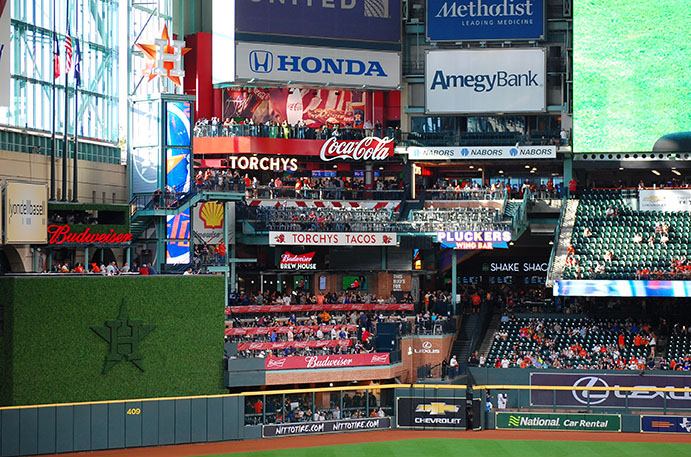
There’s a whole lot of everything going on behind Minute Maid Park’s center-field fence, including restaurants, bars, video displays, ads and even a golf shop.
The Best of Times, the Worst of Times.
On the field, the Astros quickly righted all the wrongs from their miserable first-year performance at the new ballyard. They would post winning records in each of their next six seasons, making the playoffs in three of those years—the last of which resulted in their first-ever pennant in 2005. Though swept in the World Series by the Chicago White Sox, the Astros retained fond memories of that October, most indelibly with an exhaustive 18-inning triumph over Atlanta in Game Four of the first-round divisional series to advance to the NL Championship Series, where they defeated St. Louis in six games.
The years to follow would mark a gradual and unmistakable decline as Drayton McLane seemed increasingly disinterested in a roster refresh—and soon after, the whole franchise. By 2011, he cashed out, selling the Astros to local businessman Jim Crane for $680 million, six times what he had paid to buy the club 19 years earlier.
As Major League Baseball forced Crane to switch from the National League’s Central Division to the American League West as a condition of buying the ballclub, he completely gutted the team and started from scratch. The results were palpable; from 2011-13, the Astros lost well over 100 games—including a franchise-record 111 in 2013—and Minute Maid Park threatened to become a virtual ghost town. Indeed, attendance dropped from three million in the ballpark’s early, heady days to nearly half of that—and that was just the announced figures, as no-shows became a popular non-presence.
Houston baseball fans were essentially owed renewed good times after tolerating that awful stretch of play, and they got it late in the 2010s as young cadets like tiny yet magnetic second baseman Jose Altuve, slugging outfielder George Springer and cocky third baseman Alex Bregman survived their baptisms by fire and emerged as All-Star presences, rocketing the Astros back to the top; the fans followed suit, as Minute Maid Park returned to full-house status. Houston was back in the playoffs by 2015, and two years later began performing the polar opposite of their dreadful early-decade selves by posting the first of three straight campaigns winning 100 or more games. Yet the euphoria of a first-ever world title, in 2017, and another AL pennant in 2019 would forever be tarnished when it was revealed at decade’s end that the team had employed an elaborate sign-stealing routine by using a plastic trash can behind the home dugout to bang on, telegraphing to Houston hitters what kind of pitch was coming. The Astros were heavily penalized following an MLB investigation in what many consider baseball’s biggest scandal since members of the 1919 White Sox successfully conspired to throw the World Series.
Nevertheless, the fans continue to have a good time at Minute Maid Park. They revel at the archived video cartoons from the Astrodome era exalting the crowd to yell “Charge!”, and when the seventh inning stretch comes along, not only do they sing along to Take Me Out to the Ball Game but, of course, Deep in the Heart of Texas. Beyond the funhouse atmosphere of the bleachers, Minute Maid Park has a seating set-up in line with most other new ballparks of the time: A field level, a middle “club level” tier, and a layer of luxury boxes above topped by an upper level. For those who don’t ask and thus can afford it, the Diamond Club section behind home plate offers up the ballpark’s 300 best seats, with special perks including private parking and an exclusive buffet/lounge underneath; for those with a little less but, still, lots of money, there’s the Insperity Club—a former press area transformed into an expanded luxury box with choice food/drink options as well.
Sightlines at Minute Maid Park are excellent with many seats close to the action—in some cases, too close. A somber moment occurred in 2019 when a two-year-old girl was struck by a wicked line foul off the bat of the Chicago Cubs’ Albert Almora Jr., causing permanent brain damage. As a result of the incident, all major league parks extended protective netting further down the lines, in some cases all the way to the foul pole.
High above, the retractable roof reigns to keep out the rains. Most of the time, anyway. On several occasions, heavy Houston downpours have slipped through gaps between the panels and created 200-foot waterfalls either upon the field or the spectators. Opened often through its early years, the roof is typically closed for all but 10 games in an average season. Sometimes the Astros will open the roof in the middle of a contest, but once they do they can’t close it back up unless bad weather unexpectedly arrives. When the Astros, who hold discretion over the roof’s movements, do open or close, the visiting team can appeal to the umpires—who make the final call.
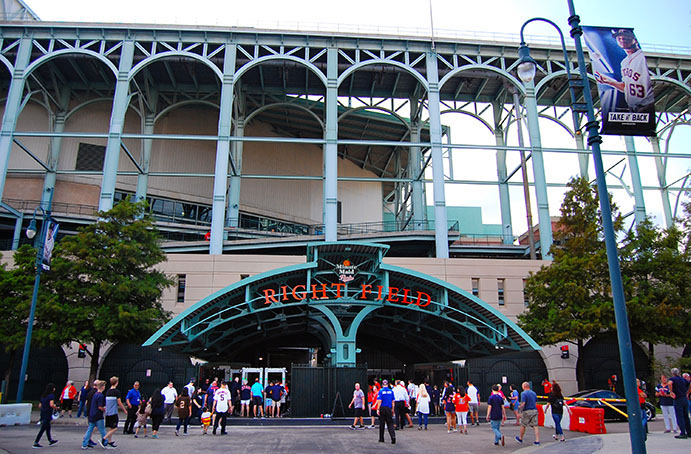
Minute Maid Park’s right-field gate appears to be under a picturesque railroad bridge; it actually holds the track for the ballpark’s retractable roof.
The Slow Growth.
Minute Maid Park was supposed to be a beacon of big-time development east of downtown Houston when it opened in 2000, with optimists envisioning a ballpark surrounded by hi-rise residential complexes, pre- and post-game magnets and park space. But over two decades later, growth has remained an elusive concept. Blocks of street-level parking, not exactly ideal postcard fodder, continue to dominate the area, while abandoned buildings stubbornly hang around as if daring the locals to do something about it. Across the elevated U.S. 59 freeway that nearly buffers the ballpark’s east side, a hoped-for spillover effect into a derelict part of the city has similarly inched along at a painfully slow rate, with numerous townhome tracts and BBVA Compass Stadium (home of Major League Soccer’s Houston Dynamo) providing here-and-there gentrification amid decaying industrial structures and purely authentic dives.
Even the one notable neighbor of Minute Maid Mark, the posh, seven-story 500 Crawford, took its time to get built. The prime site originally was to be a 36-story mixed-use skyscraper with excellent views looking over the left-field wall and into the ballpark. Then it was going to be a 25-story building. Then it became nothing, in the aftermath of a downtown downturn fueled by Enron’s collapse during the early 2000s. Finally built in 2016, the 500 Crawford includes two restaurants, both financed by Astros owner Jim Crane; if people confuse it for part of Minute Maid Park, that’s because it’s architecturally similar with the horizontal mix of red brick and limestone topped by turquoise awnings. It’s a style also aped across the street at the 12-story Westin Hotel, the shortest walk from any guest room to the ballpark.
Around the time of the 500 Crawford’s opening, the trains finally reappeared at Minute Maid Park. No, not the kind that used to rumble into Union Station, but part of the city’s emerging light rail system, with a stop one block to the south of the ballpark. By and large, most everyone showing up to Minute Maid Park gets there by car—even those who tempt fate on Houston’s notorious, congested and internally under-construction freeways.
In spite of the area’s iffy progress, there are good food options for fans within easy walking distance of the ballpark. Across the street from the main Union Station entrance is the Home Plate Bar & Grill, a poultry-leaning joint that won out over public urban planners who wanted their land for a bus station. If barbecue’s your thing—in Texas, that’s considered an automatic assumption—there’s the Jackson Street BBQ on the other side of the ballpark, which has everything that anyone salivating over an episode of BBQ Pitmasters could ask for. A few blocks to the north, just as folks ready to jump onto the Highway 59 on-ramp, they might want to detour into Irma’s Original, a colorful, enduring Mexican establishment.
People party it up atop the Union Station roof during an Astros game. Below, the 422-foot marker was placed at the request of former Houston owner Drayton McLane, who wished for someone to send a fly ball through his office window above. (Flickr—joevare)
Until the Mechanisms Give Out.
While there’s been a troublesome trend of retro-era ballparks being given short lifespans as impatient team owners abruptly pine to move on to their idea of the next best thing, the Astros have been solidly content with Minute Maid Park. In 2018, they extended their lease through 2050, which makes perfect sense as that’s the year the mechanisms moving the retractable roof are expected to give out. It remains to be seen whether the surrounding downtown area will finally grow up and embrace Minute Maid Park with an inviting, interactive community that could turn into Wrigleyville, Texas Style. But wherever the fans come from—whether it’s the burbs, within the Loop or just down the street from the financial district—Minute Maid Park will continue to provide the thrill of victory, the agony of defeat and, hopefully less likely, the shame of scandal. And if it’s a nice evening, they might even leave the roof open for you and take it outside.
Houston Astros Team History A decade-by-decade history of the Astros, the ballparks they’ve played in, and the four people who are on the franchise’s Mount Rushmore.


